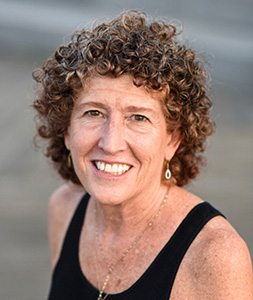In late March of 2020, Alicia R. called the intake line at Service Program for Older People (SPOP), a New York City-based behavioral health care provider for older adults. This was during the peak of the initial COVID-19 outbreak in New York City and all residents were advised to remain in their homes. The shelves at neighborhood grocery stores had been stripped of toilet paper, bleach, pasta, vegetables and meat, and commercial food delivery services had waitlists as long as a week. The streets were quiet except for the sound of ambulances and the city’s hospitals were setting up tents to accommodate emergency patients.

Nancy Harvey, LMSW
Alicia described herself as an 82-year-old Spanish-speaking woman living alone in a small apartment in New York City. She was experiencing acute fears and anxiety and had been referred to SPOP by a friend. When she spoke with SPOP’s bilingual intake specialist, Alicia said she hated being confined to her apartment and feared that her appliances were the source of dangerous emissions. She was extremely anxious and was immediately flagged for fast-tracked assessment and admission to the SPOP clinic.
The intake specialist then administered the SPOP 360, a tool designed to assess social determinants of health, which our staff had developed and begun implementing just a few months earlier with the support of the Isaac H. Tuttle Fund. The SPOP 360 is available in Spanish and English, and we use it to evaluate individuals and connect them to other service providers promptly so that their concrete needs are addressed even before they begin receiving therapy. Using the tool has allowed us to take a far more holistic approach to older adults’ health and to gain a deeper understanding of how factors like food or housing insecurity can affect their psychological well-being.
Thanks to the expanded assessment, the intake specialist learned that Alicia had not eaten for 24 hours, and she immediately initiated a three-way call to connect her to a free meal delivery program. Within fifteen minutes of her first contact with SPOP, Alicia was enrolled in the meal system and scheduled for her first delivery; she also had an appointment for a comprehensive assessment with a Spanish-speaking psychiatrist. Most important, the rapid interventions meant that she did not need to call 911. Alicia is now receiving treatment via telehealth and our intake specialist continues to check in with her regularly to make sure that she has adequate food and access to health care.
SPOP has assessed hundreds of older adults during the pandemic and connected them to other service providers. Housing and food insecurity were the most urgent needs, particularly during the peak weeks of the pandemic, followed by community and social support, including online support groups for those managing illness, caregiver distress, or loneliness. We also connected individuals to case management services, medical care, substance use detox programs, and online learning opportunities. These connections, together with the behavioral health services that SPOP provides, have been a lifeline for isolated and vulnerable older adults.
This year we also added an extra social determinant of health to our screening: technology. We now interview all clients about the technology available to them, which can include landline telephone, smartphone, computer, tablet, and access to an internet connection. We also ask about their skills or experience using technology, and we offer everyone a one-hour tutorial and ongoing support in how to participate in therapy sessions via telephone or Zoom. These services are available in Spanish and English.
We had no idea how tech-savvy our client population was. We work with an older population – 60% of our clients are over age 70 – and we had never even broached the idea of anything other than in-person sessions. The response to technology has been overwhelmingly positive, thanks to the intensive training and technical support that our intake specialists have provided – in fact, some of our most change-averse clients have been the most eager to learn new skills.
The pandemic has highlighted the importance of screening for social determinants of health and connecting individuals to appropriate services. However, it has also highlighted the digital divide and vast racial and economic disparities among our client population.
Justin, a 72-year-old participant in our Personalized Recovery Oriented Services (PROS) program, qualifies for a free SafeLink cell phone through his Medicaid benefits. When our PROS program was meeting in person Justin participated in 8-10 rehabilitation groups each week on such topics as Managing My Money, Move Your Body, and Understanding My Meds. However, because his monthly phone plan includes only 300 minutes, he is unable to participate in the 40-minute groups during the pandemic and now meets with his recovery counselor just once a week. Other clients tell us that they are able to purchase a tablet but cannot afford monthly internet connectivity. These are situations that increase the vulnerability of our most marginalized clients.
Looking ahead, we know that technology is here to stay – and that it should be considered a standard determinant of health. This also means that it is time to address the digital divide and make certain that all Americans have access to internet and technology. Among the many lessons the pandemic has given us, this may be the most important one.
Nancy Harvey, LMSW, is Chief Executive Officer at the Service Program for Older People (SPOP). Launched in 1972 and independently incorporated in 1979, Service Program for Older People (SPOP) is one of the largest and longest-standing agencies entirely dedicated to providing behavioral health care for older adults. Please visit our website at www.spop.org.




